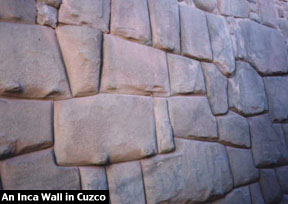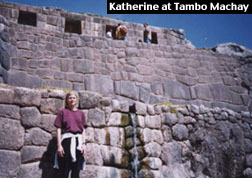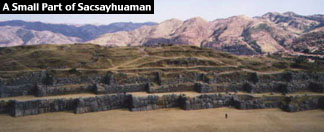
From July 8th to August 4th, 1998, truk and
Katherine traveled through various areas of central,
southern and coastal Peru, northwestern Bolivia, and northern Chile. The
following text is
taken from their diaries, with truk's writing in a normal font and Katherine's
in italics.
If you have an corrections or comments, please email
them to us [truk@truk.com].
 16 Julio 1998 (CUZCO; written in AGUAS
Calientes). Ummm, I'm looking for a word here. oh, yeah! "Overrated."
That's the word. It perfectly describes Aquas Calientes and the entire area
around Machu Picchu. The scenery here is incredible, with mountains erupting
out of the fertile valley like giant teeth, sharp and sheer, with vegetation
clinging to the cliff faces, which occasionally turn upside-down and continue
ever upward. No, I love the natural aspects of this place. It's the human
influence (other than Machu Picchu itself) that I can't stand.
16 Julio 1998 (CUZCO; written in AGUAS
Calientes). Ummm, I'm looking for a word here. oh, yeah! "Overrated."
That's the word. It perfectly describes Aquas Calientes and the entire area
around Machu Picchu. The scenery here is incredible, with mountains erupting
out of the fertile valley like giant teeth, sharp and sheer, with vegetation
clinging to the cliff faces, which occasionally turn upside-down and continue
ever upward. No, I love the natural aspects of this place. It's the human
influence (other than Machu Picchu itself) that I can't stand.
We woke early this morning to catch the 6:30 train to Aqua Calientes and Machu Picchu. So far, this day of the trip has been very disappointing. There is no train to the jungle town (Quillabamba) at the end of the tracks due to El Nino flooding. Aqua Calientes, described in Lonely Planet as [paraphrased] "a tiny, sleepy town, and a nice place to stop if you want a long day at Machu Picchu," is a sham. Yes, it is tiny here. But it's also overrun with tourism, people and noise. There are a number of hostels that have sprung up since LP was published. I suspect that tourism has arrived so rapidly that the city has not adjusted yet. Even now (at 9:45 pm), music plays in the Plaza de Armas, and fire crackers are being sent, BANG, into the air. The hot baths are, however, in working order for s/ 5. This town damages the spirit, especially considering that it is at the base of some of the most infamous archaeological / cultural / historic sites in the world. A lonely river runs through here, but the land on the banks is polluted with trash. It's like all the tourists came and the townspeople forgot how to take care of their space.
Kath and I went on a walk from Aquas Calientes to the point where the trail starts up to Machu Picchu proper. Incredible scenery, rushing white water rapids, the sky alive with swallows. The place is awake and trembling with, well, life. However, as the bottom of the big rocks back in town, peddlers of all types take over the sidewalks, gringos dominate the streets and saunter around aimlessly waiting for a train, and the "small town" takes on the life of an aged, wealthy flamingo dancer, still dressed up but with little of what made her important in the first place. These folks should really rediscover the word "quaint."
Kath and I made the flight to Cuzco. We tried a few hostels before finding the Hostel Rojas to the north of the Plaza de Armas. Situated, we went to breakfast at a wonderful place beside the cathedral and then wandered down the Avenue del Sol. Here, we located an Internet cafe and spent a good hour writing friends. Then, we purchased a tourist ticket that gets you into particular sites around the city and set about seeing museums. We spent the rest of the day hopping from place to place. That night, we ate at a place across the street, took a chance on a nearby "couch bar," and hit the sack.
Cuzco is overrun with tourists - not that every hotel is full, but enough that the local economy has "modernized" to fit travelers more than the other cities. I heard more English being spoken today and used more English (outside of conversation with truk) today than I have in the last week. There are tons of street vendors and little boys wanting to shine shoes and little children selling candy on the street. During some times of the day, the Plaza de Armas has a carnival-like atmosphere.
 Today, we did the museum-thing.
First, the Inca Museum, which is, by far, the best and most comprehensive
of them all. This one, ironically (or not), was not part of the tourist
ticket we paid 10 bucks for. Then, we hit the regional history museum. This
was a smaller version of the Inca Museum with things less adequately marked
/ described. It is, however, a decent in-depth look at the Cuzco area, from
pre-Incan to post-colonial times. For lunch, I wanted pizza, so we ate at
Maggy's Cafe on Gringo Alley. Afterwards, we went to the Contemporary Art
Museum. Some of the paintings and mixed media were interesting - more interesting
to me than a lot of American Contemporary art. To me, there is so much more
emotion / connection with the self and others expressed in the contemporary
art here - even the colors are well chosen. We left the art world to head
for the Santa Castilla Monastery. It was an interesting landscape for a
museum filled with many religious paintings and relics. It is quite fitting
to have religious relics in a place where relics of a changing church still
live, work, and worship. The halls of the monastery were lined with various
representations of Jesus, Mary and saints. We walked the cold halls from
room to room. These rooms must have been old sleeping quarters of the sisters.
There was a large and quite beautiful sanctuary in the monastery, too, of
which only 1/2 is open to the public.
Today, we did the museum-thing.
First, the Inca Museum, which is, by far, the best and most comprehensive
of them all. This one, ironically (or not), was not part of the tourist
ticket we paid 10 bucks for. Then, we hit the regional history museum. This
was a smaller version of the Inca Museum with things less adequately marked
/ described. It is, however, a decent in-depth look at the Cuzco area, from
pre-Incan to post-colonial times. For lunch, I wanted pizza, so we ate at
Maggy's Cafe on Gringo Alley. Afterwards, we went to the Contemporary Art
Museum. Some of the paintings and mixed media were interesting - more interesting
to me than a lot of American Contemporary art. To me, there is so much more
emotion / connection with the self and others expressed in the contemporary
art here - even the colors are well chosen. We left the art world to head
for the Santa Castilla Monastery. It was an interesting landscape for a
museum filled with many religious paintings and relics. It is quite fitting
to have religious relics in a place where relics of a changing church still
live, work, and worship. The halls of the monastery were lined with various
representations of Jesus, Mary and saints. We walked the cold halls from
room to room. These rooms must have been old sleeping quarters of the sisters.
There was a large and quite beautiful sanctuary in the monastery, too, of
which only 1/2 is open to the public.
The next day, we bought a train ticket to Machu Picchu, looked in vain for a mini-bus to take us to Tambo Machay, and settled on a cab that rooked us for s/ 20. The walk back into town was glorious, though. The ruins were amazing, especially the area around the Inca Baths, Qenko (where bizarre tunnels and zigzagging channels were carved into the rocks) and Sacsayhuaman (the head of the puma-shaped city of Cuzco; when the Incas set about redesigning the city, they built it to look like a puma from the air, with Sacsayhuaman as the head). Kath and I came to appreciate the spectacular workmanship and skill the Incas possessed in putting together the stone structures so that the stones fit together perfectly. Back in Cuzco later that afternoon, we read several accounts of how the Spanish tore up the larger Incan buildings to use their foundation as the bottom floor of a Spanish-constructed building. Ironically, after any of Cuzco's many earthquakes, the Incan-built foundation, possessing no concrete or nails or anything other than incredible stonework, was often the only thing left standing.
Between the Puca Pucara and Qenko sites, a little boy came bounding across the field with a puppy in tow. The puppy was very cute, and the boy offered it up to us for petting. We were not sure what he wanted us to do, but he kept talking and pushing the puppy towards us. I am not sure if he was selling it or giving it away. They were both cute - the boy and the dog. Perhaps the boy just wanted some company.
 Sacsayhuaman is so large that it is difficult
to appreciate what the Inca were trying to accomplish there. In one area,
there is an arena-like space. In another area, there are walls that zig-and-zag
and some that converge and become a room. Also, there is a mound of smooth
rock with grooves inside that connects one area of the site to another.
It was difficult to climb. I wonder if it is natural or was carved to look
that way. In the arena area, there is a "bleacher section" and
even "box seats" still beckoning lost-since diminished crowds.
The site itself stands high above Cuzco and was 80% demolished by the Spanish,
chopped up for building materials. We climbed down a steep embankment toward
the road, followed the road, and met up with the massive steps that connect
Cuzco with the ruins. It was a a very pleasant day - hiking, looking, resting
- being in the fresh air felt good.
Sacsayhuaman is so large that it is difficult
to appreciate what the Inca were trying to accomplish there. In one area,
there is an arena-like space. In another area, there are walls that zig-and-zag
and some that converge and become a room. Also, there is a mound of smooth
rock with grooves inside that connects one area of the site to another.
It was difficult to climb. I wonder if it is natural or was carved to look
that way. In the arena area, there is a "bleacher section" and
even "box seats" still beckoning lost-since diminished crowds.
The site itself stands high above Cuzco and was 80% demolished by the Spanish,
chopped up for building materials. We climbed down a steep embankment toward
the road, followed the road, and met up with the massive steps that connect
Cuzco with the ruins. It was a a very pleasant day - hiking, looking, resting
- being in the fresh air felt good.
That night, we tramped down "Gringo Alley," a small street running perpendicular to the Plaza de Armas and filled with foreigners, to eat some Mexican food. At the restaurant, we met an American from San Francisco named John. We talked for a while, moved on to the "couch bar" and talked until late. The next morning, we had to get up at 5:15 to make the 6:30 train to Machu Picchu. Somehow, we paid for the room and laundry, got some money out of an ATM, caught a cab to the station, and made the train.
The trip was great, with amazing views. The transition from high plains to high jungle was subtle but astounding. Once here, we trekked up to Gringo Bill's hostel ($30 a night!) and explored the town. As I've said, not much here. We loitered most of the morning, took a walk, and came back to Aquas Calientes about 2:15 to get a ticket on to Quillabamba, where we wanted to go the next day. After standing in a ten-meter line for over an hour, we were told that El Nino had washed out part of the track and we couldn't go. We couldn't even buy a ticket back to Cuzco until the next day. Frustrated, we sat around the square, bought some supplies for tomorrow, sulked, played some cards, went to dinner and came back to Bill's to crash.
Maybe tomorrow will be a better day.
Lima
-> Huancayo -> Ayacucho
-> Cuzco -> Machu Picchu/Puno ->
Lake Titicaca ->
La Paz -> Arequipa
-> Colca Canyon -> Nazca/Pisco/Lima